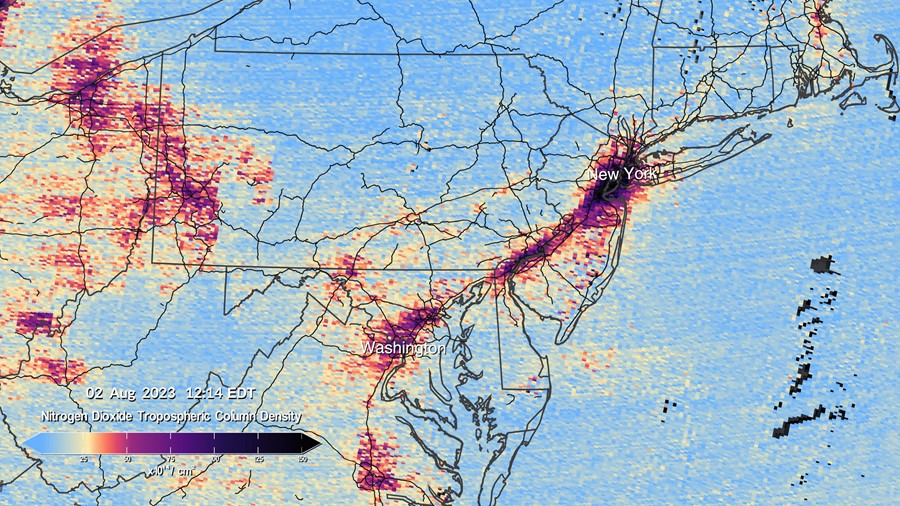The space agency’s Tempo project gets to the root of the toxic gases we’re pumping into our atmosphere
Many people dismiss space exploration as a pointless pursuit at best, or at worst a sinful waste of resources in the middle of the climate crisis. After all, a single rocket launch can produce hundreds of tonnes of carbon dioxide. On the other hand, there are a few arguments in favour of blasting rockets beyond our atmosphere. Firstly: where’s your sense of childlike wonder? Secondly: seeing Earth from an outside perspective could actually help fix our dire situation down on the planet’s surface.
Last week, NASA shared a series of maps compiled from data gathered by Tempo, a tool that was sent into space on a SpaceX rocket back in April. Orbiting 22,000 miles above Earth, Tempo measures pollution levels in the atmosphere across the US on an unprecedented scale. According to scientists, the resulting illustrations of our effect on the planet – which have been turned into an animated visualisation by NASA – could prove “game-changing”.
But what exactly is Tempo, anyway? Also known as the Tropospheric Emissions: Monitoring of Pollution instrument, it’s actually part of NASA’s ongoing Earth Venture Instrument mission, which aims to help humanity understand the current state of our home planet, and to predict future changes.
More specifically, Tempo is a space-based spectrometer that measures sunlight reflected and scattered off the Earth’s surface, clouds, and atmosphere. Why? Because gases in the atmosphere absorb sunlight, and by measuring the wavelengths of light that’s reflected back, we can determine the amounts of these gases at any given time. This is especially important when it comes to harmful gases like nitrogen dioxide (spoiler: the numbers aren’t looking great).
Produced by burning fossil fuels for things like transportation, industry, and keeping the lights on – as well as by wildfires – nitrogen dioxide is a toxic pollutant, and can damage the health of individual humans and whole ecosystems. The amount of nitrogen dioxide in the air is measured as a “column density”, which means the total number of nitrogen dioxide molecules in a column of air above a single square centimetre of Earth’s surface.
Previously, no satellites have been able to measure the make-up of the atmosphere with such precision as they pass by the same spots on Earth day after day. Tempo, however, is in a “geostationary orbit” – meaning that it moves in sync with Earth, essentially hovering over the same spot all day long. This means that it can continuously observe pollution levels over North America, tracking changes in emissions, their causes, and the specific chemicals in the air throughout the day.
It's official! We're on and working. Check out our first light images, which give a preview of our ability to track nitrogen dioxide on an hourly basis in geographic areas as small as four square miles! #AirQuality
— TEMPO Mission (@TEMPO_Mission) August 24, 2023
Full story: https://t.co/JRGWuJx7yzpic.twitter.com/XVqGNH5S5G
Fears about the climate crisis are understandably on the rise as the world feels its effects, and especially as we enter a new, more extreme phase of Earth’s natural weather cycle. According to scientists, Tempo is a big step toward turning that fear into useful actions, as we gain a better understanding about the specific problems we face and the possible solutions (and no, the answer probably isn’t to just blast a big umbrella into space).
“Neighbourhoods and communities across the country will benefit from Tempo’s game-changing data for decades to come,” said NASA administrator Bill Nelson in a statement on the release of the first Tempo visualisations, suggesting that it couldn’t come soon enough. “This summer, millions of Americans felt firsthand the effect of smoke from forest fires on our health.”
NASA is committed to making it easier, Nelson adds, for both regular people and important decision makers to access the data gathered by Tempo, to “monitor and improve the quality of the air we breathe, benefitting life here on Earth”. In the meantime, try not to freak out when you see the swathes of toxic gases hanging above many of our major cities.
Join Dazed Club and be part of our world! You get exclusive access to events, parties, festivals and our editors, as well as a free subscription to Dazed for a year. Join for £5/month today.





